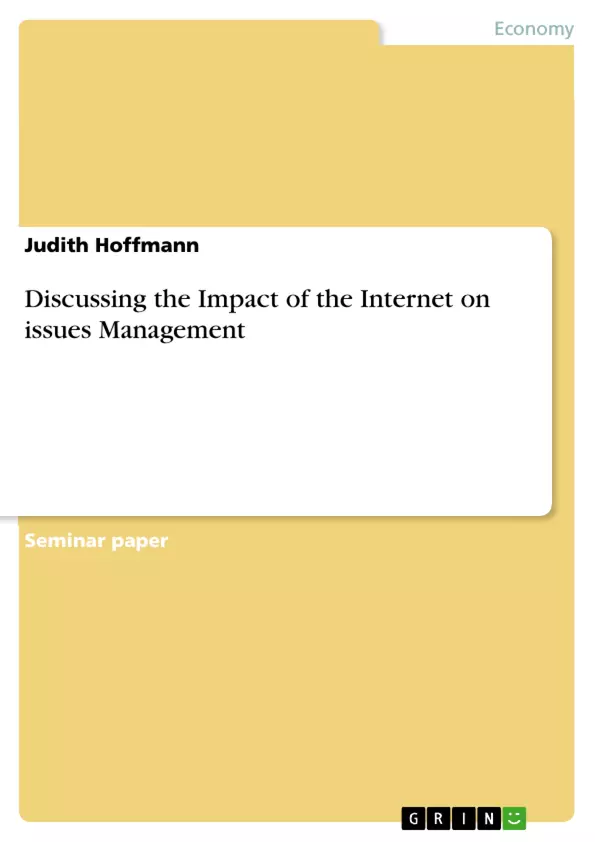When Patrick Henry spoke those words more than two hundred years ago, the development of issues management was far away. Nevertheless his words describe what can be called the essence of issues management (IM) over the past 25 years. According to Jones and Chase (1979) issues management can be defined as a tool which helps companies to identify, analyse and manage emerging issues and allows for responding to them before they become public knowledge. Issues emerge, when a stakeholder has a problem with the company relationship, but a problem only turns into an issue when it moves from private to public concern (Coombs 2002).
According to Niklas Luhmann (1996 [2000]) who states whatever we know about our society, we know through the mass media, IM used to be concerned with monitoring, influencing and reacting on media events, and thus changing company reputation in the eyes of the public (Moloney, 2000, Philipps, 2000). Accordingly media could be seen as a transmitter between stakeholder and organisation. Due to the gatekeeper function of journalists the louder voice of industry naturally has had more chance to be heard and get media coverage (MacLeod, 2000). This has led to a corporate communication which used to be a merely one-way activity in the times of traditional mass media (De Bussy, Watson, Pitt and Ewing, 2000).
The internet has changed this situation. Not only that it allows for the first time real two-waycommunication (White, Raman, 1999), it has also added a new dimension to direct communication between organisations and their stakeholders (de Bussy et al, 2000). PR people as former gatekeepers of company’s reputation are now bypassed (Philipps, 2000). People are communicating not only with the company if they have problems to address. They are communicating with each other. Recent PR books (Haig, 2000, Philipps, 2001, Middleberg, 2000) work already as a modern Cassandra, exhorting companies to be aware of the potent ial danger of the internet.
Inhaltsverzeichnis (Table of Contents)
- Introduction
- Internet Impact on Issues Emergence
- Grunig's Situational Theory (1984)
- The Catalytic Model (Crable, Vibert, 1985)
- Hainsworth's Cycle (1990)
- The Lifecycle by Femers, Klewes and Lintemeier (1999)
- Times have changed
Zielsetzung und Themenschwerpunkte (Objectives and Key Themes)
This paper explores the impact of the internet on issues management (IM). It analyzes different models of issues development and characterizes the internet's influence on them. The paper then discusses the advantages and disadvantages the internet presents for IM, ultimately proposing further research on the internet's impact on stakeholders rather than solely focusing on practitioners' perspectives.
- The evolution of issues management in the context of the internet's influence.
- Analysis of how the internet accelerates the emergence of issues.
- Exploration of the internet's impact on various models of issues development.
- Assessment of the internet's advantages and disadvantages for issues management.
- Emphasis on the importance of understanding stakeholder usage of the internet.
Zusammenfassung der Kapitel (Chapter Summaries)
The introduction sets the stage by defining issues management and outlining the paper's scope. It highlights the changing landscape of communication due to the internet's influence and its implications for issues management.
The chapter "Internet Impact on Issues Emergence" examines the impact of the internet on the development of issues. It analyzes different models of issue emergence, highlighting how the internet accelerates the transition from latent publics to active publics and compresses the timeframe of issue development.
The chapter "Times have Changed" explores the internet's implications for transparency and response in issues management. It discusses how the internet empowers stakeholders to communicate with each other and bypass traditional gatekeepers, creating new challenges and opportunities for organizations.
Schlüsselwörter (Keywords)
Issues management, internet, communication, stakeholders, transparency, reputation, crisis management, online activism, public relations, media, information, models of issues emergence, situational theory, catalytic model, Hainsworth cycle, lifecycle, social media.
- Quote paper
- Judith Hoffmann (Author), 2005, Discussing the Impact of the Internet on issues Management, Munich, GRIN Verlag, https://www.grin.com/document/50838



